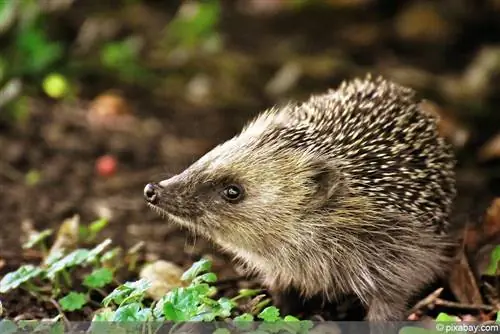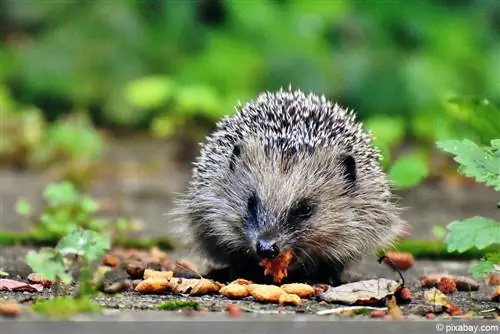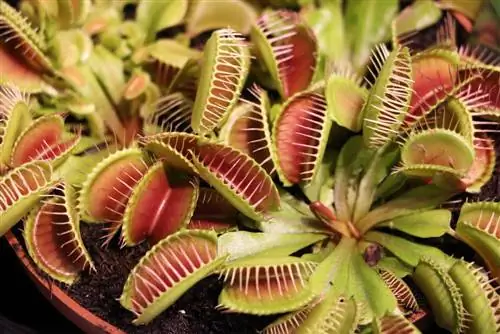- Author admin [email protected].
- Public 2023-12-17 03:39.
- Last modified 2025-01-24 12:45.
From the beginning of October, the food supply for hedgehogs decreases significantly. By this time, most perennial males have already gone to their winter quarters. If you meet hedgehogs in the garden, they are almost always mothers or young hedgehogs. The hedgehog, which may still be weakened from raising the young, now urgently needs energy-rich food in order to eat up the winter fat. You can often see a hedgehog eating a pot of cat food.
hedgehog children
Most hedgehog children are born in August. In warm regions such as wine-growing regions this can be a little earlier. A mother hedgehog usually gives birth to between two and seven young animals, which, by the way, are born with quills. The spines are still very soft at this point. The eyes open after about two weeks. The hedgehog children cannot be seen in the garden until they are three weeks old at the earliest, when they go on their first excursions with their mother. The hedgehogs still find enough food in the garden until late September and can easily gain around 10 g of weight per night. The young hedgehogs usually leave their mother around the end of September and migrate to other areas.
Instinct also tells the young hedgehog children that they can only survive the winter with good fat deposits. The search for food during this time is very strenuous for the hedgehogs and also takes a lot of time. When looking for food, young hedgehogs sometimes forget to build a nest in time. The protective nest is then built very late and not with the necessary care. One of the most important reasons why so many young hedgehogs die in the cold season.
hibernation
A few weeks later than the male hedgehogs, the female and young hedgehogs also curl up into a ball and begin their hibernation. Your metabolism is reduced to a minimum during this time. The body temperature drops from 36 degrees to five degrees and the heart no longer beats around 200 times per minute, but only eight to twenty times. And the breathing frequency also reduces from forty to fifty to just three to four. Sometimes the hedgehogs wake up briefly but then stay in their nest. Towards the end of March, the male hedgehogs finish hibernation first, followed by the female hedgehogs in April.
Feeding in autumn
While supplementary feeding of hedgehogs is not necessary or even harmful between May and September, you can support the animals by offering them food from the end of September, when the food supply has decreased significantly. However, when feeding a hedgehog, you should do it correctly. In order to eat a layer of fat, the animals need a diet rich in fat and protein. Hedgehogs cannot tolerate fruit and vegetables because, even in nature, they feed almost exclusively on insects and other invertebrates. Suitable are:
- Wet cat or dog food
- Scrambled eggs (unseasoned)
- cooked poultry meat
- cooked, unseasoned minced meat
The animals are given water to drink, which - like the food - should be placed in a flat, stable bowl on the floor. Although hedgehogs like milk, they don't get it. Milk contains lactose, which the animals cannot tolerate and get severe diarrhea.
Tip:
Dry hedgehog food should not be given as complete food, but should only be mixed in small parts with the protein food mentioned above. The commercially available hedgehog food has a very high proportion of carbohydrates.
Wintering indoors
Only in absolutely exceptional cases should you take hedgehogs into your house to overwinter. Animals that are outdoors in moderate temperatures until November should only be fed and supported with suitable materials when building their nests. A hedgehog really needs help when:
- he is out and about during the day in persistent cold or snow
- he is showing signs of malnutrition
- he is sick or injured
If a hedgehog is underweight, you can tell by the indentation behind its head. This indentation is called the hunger line. Sick hedgehogs are generally apathetic, their eyes are slit-shaped and sunken. If you touch the animal, it usually doesn't curl up.
Vet visit

While you can support underweight hedgehogs with food, indoor shelter and necessary hibernation, sick and injured animals need urgent medical attention. Therefore, contact an animal shelter, local veterinarian or hedgehog shelter immediately.
Hibernation weight
If a hedgehog only reaches the minimum weight required for hibernation shortly before or even after the onset of winter, you have to wait until spring before releasing it back into the wild. Depending on age and size, the following values should be used as a guide:
- Young hedgehog: 600 to 700 g
- older animals: depending on size 1000 to 1400 g
In warm quarters, the hedgehog must be provided with suitable food and drinking water until it no longer touches its food. Check the hedgehog's weight periodically to make sure the animal is gaining weight. It can take either a few days to reach this point, or even weeks for severely underweight hedgehogs. Clean the house and the run daily.
Feeding in the house
A varied diet is the be-all and end-all for he althy feeding of the hedgehog during human overwintering. Therefore, the food must be put together with great care. The following things should be taken into account:
Essentials
As insectivores, the animals primarily need proteins and fats. However, since the insects from your own garden can be carriers of parasites, it does not make sense to feed them to a hedgehog. Instead:
- Cat food (without sauce)
- Dog food (wet food)
- Eggs (either hard boiled or scrambled)
- cooked poultry meat
- Minced meat (cook only briefly)
Corn oil is ideal for frying as it contains many components that are beneficial for the animals.
Additives
Fiber and also a few carbohydrates are essential for good digestion. Simply mix the following products into the basic foods:
- Oatmeal
- Wheat bran
- Dry food especially for hedgehogs
Additional vitamins or minerals must only be given as prescribed by a veterinarian. You can also mix individual staple foods together or vary the additives. One tablespoon of bran or two tablespoons of oat flakes or dry hedgehog food are mixed per portion (approximately a 150 g yoghurt cup full) of basic food. You may need a little water to moisten it. Always feed the food at room temperature (never hot or from the refrigerator).
Tip:
Hedgehogs tend to form tartar. Therefore, give them some cooked chicken (wings, neck) with bones but without skin once a week to “brush their teeth”.
Do not feed
Vary the food every two to three days at the latest so that the hedgehog does not have a one-sided diet. There are some things that hedgehogs eat but cannot tolerate. These include:
- Milk (offer water as a drink)
- Nuts and raisins
- Fruit
- spiced foods
- Vegetables and salad
- Dairy products (such as yogurt, quark and cheese)
Tip:
If your hedgehog gets diarrhea, you should definitely consult a veterinarian.
Food recipes
The following variants have proven to be a suitable daily ration for feeding a medium-sized young hedgehog:
- Fry 1 scrambled egg (60 g) with 1 teaspoon of corn oil, mix with 2 tablespoons of dry hedgehog food
- Fry 60 g ground beef with 1 teaspoon of corn oil, mix in 1 tablespoon of wheat bran
- Fry 30 g ground beef with corn oil, mix in 1 boiled egg, 2 tablespoons of oat flakes and a little water
- Mix 100 g of wet cat food with 2 tablespoons of dry hedgehog food
- Mix 100 g of cooked poultry meat with 2 tablespoons of oat flakes and 1 teaspoon of corn oil
Induce hibernation
It can happen that a hedgehog just doesn't want to go to sleep. In this case, the animal is deprived of all food for a period of three days and only fresh drinking water is provided. Since a lack of food is also one of the triggers for hibernation, a he althy hedgehog will go into hibernation. As a precaution, put an emergency ration of a mixture of cat food and hedgehog dry food in the enclosure after three days.
Accommodation during feeding
The hedgehog enclosure should be at least two square meters in size and escape-proof. Since the animals usually sleep during the day and are sensitive to noise, they should be provided with a quiet room with light at room temperature.
- Side walls: at least 40 cm high
- Wood or chipboard
- lay with several layers of newspaper
- Sleeping house: at least 30 cm wide cardboard (can be opened upwards)
- provided with a loophole (10 x 10 cm)
- fill with crumpled newspaper

Do not use sawdust, cat litter, straw, rags or the like to fill the house or to cover the ground. The ground cover is changed daily (in the morning) and the filling of the house when necessary (at least once a week).
Accommodation during hibernation
As long as the animal is nursed and cared for he alth, it must be kept in a warm room. A he althy animal should definitely hibernate even when hibernating at home. For hibernation, the hedgehog should be housed in a place with low temperatures so that it actually sleeps.
And don't forget: hedgehogs are solitary animals, so each animal needs its own house and enclosure.
- Temperature: similar to outside temperature
- at temperatures above 6 degrees the animal falls into a debilitating state of twilight
- no direct sunlight
- Winter better outdoors
- protected space on balcony or terrace
- Garden house
Tip:
Basements or rooms in the house are usually unsuitable because they are too warm.
Bedroom
A cardboard box that you can fill with some leaves or straw is suitable as a sleeping house for the feeding time. For hibernation, you can put this sleeping house in a larger box or choose the following version, which is better protected from moisture:
- Construction made of chipboard
- Edge length about 40 cm
- Insulation material: crumpled newspaper
- also insulate under the house
- Do not use Styrofoam (it is not breathable)
- Install a loophole of a suitable size (front opposite the bedroom entrance)
Control
Do not disturb the hedgehog once he has retired to hibernate. If you keep checking to see if he's really sleeping, you might wake him up. A very simple and effective control is possible with an adhesive tape and a piece of toilet paper. Tape the toilet paper at the top and bottom with two strips of tape in front of the exit from the house. If the animal has woken up and left its house, the paper is destroyed.
If you are worried because you haven't seen your hibernator for a long time, you can carefully look into the sleeping house. While on a sleeping hedgehog you can only see the spines that rise up in slow motion when you touch them, on a dead hedgehog you can often see the head and paws.
Waking up
When the hibernator wakes up depends not only on the weather conditions, but also largely on gender. Male hedgehogs usually wake up around the end of March and females about three weeks later around mid-April. At the end of hibernation, the hedgehog has lost a lot of weight. If you were to release the animal you overwintered into nature, it would find little food and would not have a hibernation nest in the garden to which it could retreat again. So feed the hedgehog again until it weighs as much as it did before hibernation. This happens quite quickly and within two to three weeks he should be back to his original weight.
Rewilding
Hedgehogs that have overwintered indoors should be released back into the wild as soon as possible. How this release takes place depends on whether it is a young hedgehog or an older animal.
Older animals
A hedgehog has an excellent location memory. Therefore, be sure to return it to the place where you found it. There the animal already knows shelter options, fences, walls and places that are particularly rich in food. If an animal is not released into the wild where it was found, it first has to completely reorient itself and is therefore very much at risk at first. All hedgehogs weighing over 250 g should be returned to their original location if they are he althy and have reached their original weight after being fed indoors.
- The transport should be as stress-free as possible
- preferably release in the evening
- choose a protected spot under a hedge or in the bushes
- Create a nest of hay for the animal
- put out some more food
For the sake of the environment, do not leave any boxes or food plates in the wild. If you have found the hedgehog in your garden, you can put a wooden house with straw or hay in a protected corner of the garden. Offer him his usual food and water for up to two weeks, which you place in a bowl in front of the entrance.
Cubs
Animals taken into the nest (weighing less than 250 g) should have reached a minimum weight of 600 to 700 g when released into the wild. Since they were still too young in autumn to orientate themselves in their surroundings, the hedgehog first has to get used to freedom. This also applies to found animals that cannot be returned to the place where they were found.
- Release into the wild via an outdoor enclosure
- for example a rabbit or guinea pig enclosure
- Minimum height: 50 cm
- Minimum size: 4 m² per hedgehog
- place a rainproof house under a hedge or bushes
- Continue feeding for about two weeks
- then simply open the enclosure (do not remove it)
- maintain the feeding station for another two weeks
This gives the hedgehog the opportunity to slowly feel its way out of its familiar, small environment and into its new surroundings. However, never simply place the enclosure and the house in an open area, but rather protected under trees or bushes. Cleanliness is an absolute must here too. Therefore, clean the house and enclosure daily and rinse used water and food bowls with hot water.
Conclusion
Hedgehogs should only be hibernated indoors in exceptional cases. They have a better chance of surviving outside. If you take in a sick or underweight animal, you should first have it examined by a veterinarian. Feed the hedgehog up to its normal hibernation weight and be sure to encourage it to hibernate.






